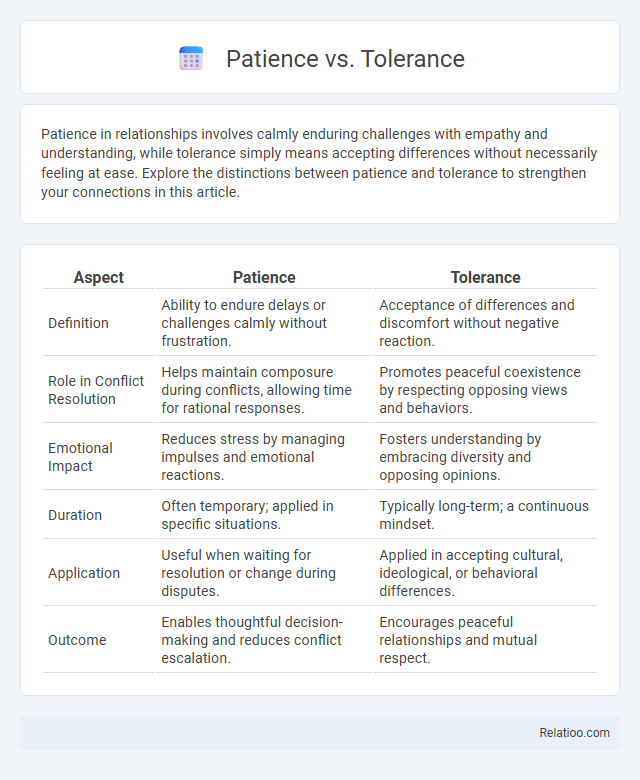Patience in relationships involves calmly enduring challenges with empathy and understanding, while tolerance simply means accepting differences without necessarily feeling at ease. Explore the distinctions between patience and tolerance to strengthen your connections in this article.
Table of Comparison
| Aspect | Patience | Tolerance |
|---|---|---|
| Definition | Ability to endure delays or challenges calmly without frustration. | Acceptance of differences and discomfort without negative reaction. |
| Role in Conflict Resolution | Helps maintain composure during conflicts, allowing time for rational responses. | Promotes peaceful coexistence by respecting opposing views and behaviors. |
| Emotional Impact | Reduces stress by managing impulses and emotional reactions. | Fosters understanding by embracing diversity and opposing opinions. |
| Duration | Often temporary; applied in specific situations. | Typically long-term; a continuous mindset. |
| Application | Useful when waiting for resolution or change during disputes. | Applied in accepting cultural, ideological, or behavioral differences. |
| Outcome | Enables thoughtful decision-making and reduces conflict escalation. | Encourages peaceful relationships and mutual respect. |
Understanding Patience: Definition and Importance
Patience is the ability to endure difficult circumstances, delay gratification, and persist through challenges without frustration, playing a crucial role in personal and professional growth. Tolerance involves accepting and respecting differences or discomfort, which complements patience by promoting empathy and reducing conflict. Understanding patience enhances emotional regulation, improves decision-making, and fosters resilience, essential for long-term success and mental well-being.
Defining Tolerance: Meaning and Modern Relevance
Tolerance refers to the ability to accept and respect differences in opinions, behaviors, and cultural practices without necessarily agreeing with them. In modern society, tolerance is crucial for fostering social harmony, preventing conflicts, and promoting diversity and inclusion. Embracing tolerance allows individuals and communities to coexist peacefully despite varying beliefs and lifestyles.
Patience vs Tolerance: Key Differences
Patience involves calmly enduring difficult situations without frustration, while tolerance refers to accepting or allowing behaviors and beliefs that differ from your own. Your ability to practice patience reflects emotional self-control, whereas tolerance emphasizes openness and respect for diversity. Understanding these key differences helps improve interpersonal relationships and personal resilience.
The Role of Patience in Everyday Life
Patience plays a crucial role in everyday life by helping you manage stress and maintain emotional balance during challenging situations. Unlike tolerance, which involves accepting discomfort without change, patience allows for thoughtful response and personal growth over time. Developing patience enhances decision-making and fosters healthier relationships by encouraging understanding and resilience.
Tolerance in Multicultural Societies
Tolerance in multicultural societies fosters peaceful coexistence by embracing diverse cultures, beliefs, and practices without imposing judgment or resistance. It involves recognizing and respecting differences, which helps reduce conflicts and promotes social harmony. Unlike patience that emphasizes enduring difficulties and tolerance that encourages acceptance, tolerance actively supports inclusivity and mutual understanding in diverse communities.
Psychological Benefits of Patience
Patience enhances emotional regulation and reduces stress by allowing you to calmly endure challenges without impulsive reactions. Unlike tolerance, which involves accepting discomfort or disagreement, patience actively cultivates resilience and mindfulness, contributing to improved mental well-being. Developing patience promotes long-term psychological benefits such as increased self-control, empathy, and a greater sense of inner peace.
Social Impact of Practicing Tolerance
Practicing tolerance fosters social harmony by encouraging acceptance of diverse perspectives and reducing conflicts in communities. Your ability to embrace differences promotes empathy and mutual respect, which strengthens social bonds and collaborative efforts. Tolerance, unlike mere patience or endurance, actively contributes to inclusive environments where diversity is valued and peaceful coexistence thrives.
Developing Patience: Strategies and Tips
Developing patience involves practicing mindfulness techniques, such as deep breathing and meditation, to manage stress and enhance emotional regulation. Setting realistic expectations and breaking tasks into manageable steps can reduce frustration and build tolerance over time. Consistently reflecting on triggers and adopting a growth mindset encourages resilience and long-term improvement in patience skills.
Building Tolerance: Steps to Broaden Acceptance
Building tolerance involves consciously expanding one's capacity to accept diverse viewpoints and behaviors, fostering empathy through active listening and open-mindedness. Regular exposure to different cultures, ideas, and experiences strengthens emotional resilience, reducing reactive judgments and enhancing social harmony. Developing tolerance requires deliberate practice in self-awareness and patience, allowing gradual adjustment to discomfort with unfamiliarity while maintaining respect for others' differences.
Balancing Patience and Tolerance for Personal Growth
Balancing patience and tolerance is essential for personal growth, as patience involves enduring difficulties with calm persistence while tolerance requires accepting differences and ambiguities without judgment. Developing both traits enhances emotional intelligence, reduces stress, and fosters healthier relationships by promoting empathy and understanding. Cultivating this balance enables individuals to navigate challenges effectively and build resilience in diverse social and personal contexts.

Infographic: Patience vs Tolerance
 relatioo.com
relatioo.com